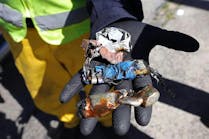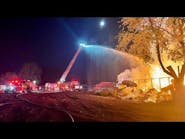Tools & Technologies: Fire Service Prepares for Change In PPE Technology
Change is an inescapable reality of our everyday lives and certainly the fire service is not immune to that reality. Sometimes, the need for change is recognized by an organization and generated internally. Other times, change occurs around us and we are compelled to adapt. Change and the consequences of change can at times be obvious – for example, when the fire service transitioned from long coats and rubber boots to modern-day fire-resistant bunker coats and pants. More often, the changes may be more subtle, yet the effects may be profoundly significant. Either way, the most successful and durable organizations recognize change as an opportunity to improve rather than as a burden.
One such external, rather subtle, yet very significant change is about to occur within the fire service. In early January, a letter from Dupont was distributed that announced a decision to discontinue the supply of Nomex filament from the fire service industry at the end of 2012. Many firefighters will not recognize the significance of this move. However, Nomex filament is the primary yarn used in the manufacturing of high-performance thermal liner face cloth fabrics present in much of today’s bunker gear. Most if not all of the premium-performing thermal liners produced by textile manufacturers such as Safety Components and Tencate incorporate Nomex filament in the face cloth of the liner. To be more specific, approximately 50% of firefighters in North America presently wear turnouts that include Nomex filament in their thermal liner. Because the discontinuation of Nomex filament affects at least half of the fire service, it certainly is not an overstatement to characterize this change as significant.
The overwhelming majority of filament-based thermal liner face cloths contain 25% or 60% filament. The remaining constituent yarns of filament-based face cloths are generally Nomex spun yarns. It is important to note here that spun yarn is vastly different than filament yarn.
Filament is employed in the face cloth of bunker gear thermal liners for two main reasons. First, the presence of filament increases the “slickness,” or lubricity, of the face cloth. A slick face cloth makes donning and doffing turnouts easier and increases wearer comfort by facilitating firefighter movement within the garments. Second, because filament is more resistant to absorbing moisture than spun yarns, filament-based thermal liners improve moisture management within the liner system by reducing the amount of moisture absorbed by the thermal liner. The result is a liner that dries more quickly than thermal liners made with 100% spun yarn.
Many fire departments are convinced of the importance of these two performance attributes and have come to appreciate and to EXPECT them in their turnout gear. As a matter of fact, nine out of the top 10 largest metro departments in the United States presently wear thermal liners with filament-based thermal liner face cloths.
It is clear the presence of Nomex filament in so many present-day thermal liners plays an important role in “setting the bar” for important performance properties that firefighters now demand of their turnouts. Given these established expectations, it will be incumbent upon the various mills to research, identify and develop alternative solutions to the use of Nomex filament in order to at least maintain those now-customary performance attributes. The mills should recognize and exploit this necessary research as an opportunity not merely to maintain these qualities, but to improve them.
An examination of any potential replacement solutions should include some context regarding the producer of Nomex filament and why the decision was made to discontinue offering it for fire service applications. Throughout its 200-plus-year history, DuPont has been a global leader in technological advancements for a variety of industries, especially the personal protective equipment (PPE) industry. Some of these game-changing discoveries include: Teflon, the treatment used in virtually all bunker gear to keep fabrics dry; Kevlar, which is used in approximately 80% of modern turnout gear outer shells to strengthen and reinforce fabrics containing PBI or Nomex fibers; and Nomex, which was the first inherently flame-resistant fiber used to protect firefighters. It’s now been over 40 years since DuPont first developed Nomex in 1967. This development commenced a new era of progress in PPE for the military, industrial workers and for first-responders – especially firefighters.
Given its utility in an ever-growing number of applications and industries, it’s no wonder that the demand for Nomex filament has grown exponentially, particularly during the last decade. During that time, DuPont has been unable to increase production at a rate sufficient to match the pace of the ever-growing global demands of the military, fire service, law enforcement, automobile industry, etc., so it has been compelled to identify options to address this growing supply and demand disparity. Reluctantly, one aspect of the strategy selected was to discontinue the use of Nomex filament within the fire service industry.
Although necessary, this was apparently a difficult decision to make because DuPont has always been known as a collaborative partner of the fire service. Conversely, the company could feel somewhat better about making this painful decision because it felt confident in the availability and quality of an alternate filament fiber to immediately replace Nomex filament.
In fact, fundamental to the decision to eliminate Nomex filament in the fire service was the knowledge that DuPont had a readily available “drop-in” filament product with similar, if not superior, performance properties. Kevlar filament is very similar to Nomex in structure and characteristics, but is also five to six times as strong as Nomex filament on an equal-weight basis. Given its similarities and strength superiority, it would be reasonable to expect at least equivalent performance from face cloths using Kevlar filament in lieu of Nomex filament. Furthermore, Kevlar has a well-established history of usage in the fire service in outer shells and thermal liners. It is therefore not a great leap into the unknown to incorporate the Kevlar filament into thermal liner face cloths.
In addition, DuPont has recently brought a new, state-of-the-art Kevlar production facility online and is confident in its long-term ability to keep pace with expected growth and demand. The Cooper River facility just outside Charleston, SC, is an investment that illustrates Dupont’s commitment to supplying Kevlar and Kevlar filament for countless years into the future.
None of this is meant to suggest that using Kevlar filament is the only alternate solution to replacing Nomex filament in fire service thermal liners. But there is no denying that the readily availability of a viable DuPont-produced replacement was a major factor in its decision to discontinue the use of Nomex filament in our industry. The fact is that textile manufacturers will consider other possible alternatives as well. Hopefully, those options will NOT eventually include the use of filaments produced overseas. In my opinion, such a development would be to the ultimate detriment of the U.S. fire service and related industries that value “Made in the U.S.A.”
In the end, the final effects and outcomes of the loss of Nomex filament to our industry remain to be seen. Optimistically, this change will be recognized as an opportunity for improvement that it represents and the consequences of this seemingly subtle change will be to the ultimate benefit of firefighters everywhere.
Henry J. Costo
HENRY J. COSTO is a battalion chief and 37-year veteran of the Philadelphia, PA, Fire Department. He has been the department’s safety officer for eight years and is chairman of the Safety Committee for Local 22 of the International Association of Fire Fighters. He also serves on the advisory board of the Firefighter Injury Research and Safety Trends (FIRST) project being conducted under the auspices of Drexel University’s School of Public Health. Costo is Metro Advocate Coordinator for the Everyone Goes Home program of the National Fallen Firefighters Foundation. In addition to holding a degree in fire science, he graduated summa cum laude from the University of Pennsylvania’s Wharton School of Business.







